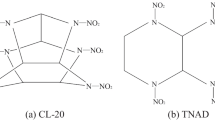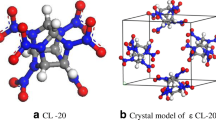Abstract
To investigate and compare the differences of structures and properties of CL-20/TNT cocrystal and composite explosives, the CL-20/TNT cocrystal and composite models were established. Molecular dynamics simulations were performed to investigate the structures, mechanical properties, sensitivity, stabilities and detonation performance of cocrystal and composite models with COMPASS force field in NPT ensemble. The lattice parameters, mechanical properties, binding energies, interaction energy of trigger bond, cohesive energy density and detonation parameters were determined and compared. The results show that, compared with pure CL-20, the rigidity and stiffness of cocrystal and composite models decreased, while plastic properties and ductility increased, so mechanical properties can be effectively improved by adding TNT into CL-20 and the cocrystal model has better mechanical properties. The interaction energy of the trigger bond and the cohesive energy density is in the order of CL-20/TNT cocrystal > CL-20/TNT composite > pure CL-20, i.e., cocrystal model is less sensitive than CL-20 and the composite model, and has the best safety parameters. Binding energies show that the cocrystal model has higher intermolecular interaction energy values than the composite model, thus illustrating the better stability of the cocrystal model. Detonation parameters vary as CL-20 > cocrystal > composite, namely, the energy density and power of cocrystal and composite model are weakened; however, the CL-20/TNT cocrystal explosive still has desirable energy density and detonation performance. This results presented in this paper help offer some helpful guidance to better understand the mechanism of CL-20/TNT cocrystal explosives and provide some theoretical assistance for cocrystal explosive design.






Similar content being viewed by others
References
Agrawal JP (1998) Recent trends in high-energy materials. Prog Energy Combust Sci 24:1–30
Sikder AK, Sikder N (2004) A review of advanced high performance, insensitive and thermally stable energetic materials emerging for military and space applications. J Hazard Mater 112:1–15
Lara OF, Espinosa PG (2007) Cocrystals definitions. Supramol Chem 19:553–557
Shan N, Zaworotko MJ (2008) The role of cocrystals in pharmaceutical science. Drug Discov Today 13:440–446
Xu HF, Duan XH, Li HZ, Pei CH (2015) A novel high-energetic and good-sensitive cocrystal composed of CL-20 and TATB by a rapid solvent/non-solvent method. RSC Adv 5:95764–95770
Guo DZ, An Q, Goddard WA, Zybin SV, Huang FL (2014) Compressive shear reactive molecular dynamics studies indicating that cocrystals of TNT/CL-20 decrease sensitivity. J Phys Chem C 118:30202–30208
Wei CX, Huang H, Duan XH, Pei CH (2011) Structures and properties prediction of HMX/TATB co-crystal. Propellants Explos Pyrotech 36:416–423
Liu K, Zhang G, Luan JY, Chen ZQ, Su PF, Shu YJ (2016) Crystal structure, spectrum character and explosive property of a new cocrystal CL-20/DNT. J Mol Struct 110:91–96
Wu JT, Zhang JG, Li T, Li ZM, Zhang TL (2015) A novel cocrystal explosive NTO/TZTN with good comprehensive properties. RSC Adv 5:28354–28359
Bolton O, Simke LR, Pagoria PF, Matzger AJ (2012) High power explosive with good sensitivity: a 2:1 cocrystal of CL-20:HMX. Cryst Growth Des 12:4311–4314
Xiong SL, Chen SS, Jin SH (2017) Molecular dynamic simulations on TKX-50/RDX cocrystal. J Mol Graphics Modell 74:171–176
Ding X, Gou RJ, Ren FD, Liu F, Zhang SH, Gao HF (2016) Molecular dynamics simulation and density functional theory insight into the cocrystal explosive of hexaazaisowurtzitane/nitroguanidine Int J Quantum Chem 116:88–96
Song KP, Ren FD, Zhang SH, Shi WJ (2016) Theoretical insights into the stabilities, detonation performance, and electrostatic potentials of cocrystals containing α- or β-HMX and TATB, FOX-7, NTO, or DMF in various molar ratios. J Mol Model 22:249
Feng RZ, Zhang SH, Ren FD, Gou RJ, Gao L (2016) Theoretical insight into the binding energy and detonation performance of ε-, γ-, β-CL-20 cocrystals with β-HMX, FOX-7, and DMF in different molar ratios, as well as electrostatic potential. J Mol Model 22:123
Li YX, Chen SS, Ren FD (2015) Theoretical insights into the structures and mechanical properties of HMX/NQ cocrystal explosives and their complexes, and the influence of molecular ratios on their bonding energies. J Mol Model 21:245
Yang ZW, Zhang YL, Li HZ, Zhou XQ, Nie FD, Li JS, Huang H (2012) Preparation, structure and properties of CL-20/TNT cocrystal. Chin J Energ Mater 20:674–679
Yang ZW, Li HZ, Huang H, Zhou XQ, Li JS, Nie FD (2013) Preparation and performance of a HNIW/TNT cocrystal explosive. Propellants Explos Pyrotech 38:495–501
Agrawal JP (2005) Some new high energy materials and their formulations for specialized applications. Propellants Explos Pyrotech 30:316–328
Foltz MF, Coon CL, Garcia F (1994) The thermal stability of the polymorphs of hexanitrohexaazaisowurtzitane, part I. Propellants Explos Pyrotech 19:19–25
Zhao XQ, Shi NC (1995) Crystal structure of ε-hexanitrohexaazaisowurtzitane. Chin Sci Bull 40:2158–2160
Vrcelj RM, Sherwood JN, Kennedy AR, Gallagher HG, Gelbrich T (2003) Polymorphism in 2-4-6 trinitrotoluene. Cryst Growth Des 3:1027–1032
Sun H, Ren PJ, Fried R (1998) The COMPASS force field: parameterization and validation for phosphazenes. Comput Theor Polym Sci 8:229–246
Bunte SW, Sun H (2000) Molecular modeling of energetic materials: the parameterization and validation of nitrate esters in the COMPASS forcefield. J Chem Chem B 104:2477–2489
Michael JM, Sun H, Rigby D (2004) Development and validation of COMPASS force field parameters for molecules with aliphatic azide chains. J Comput Chem 25:61–71
Pugh SF (1954) Relations between the elastic moduli and the plastic properties of polycrystalline pure metals. Philos Mag 45:823–843
Pettifor DG (1992) Theoretical predictions of structure and related properties of intermetallics. Mater Sci Technol 8:345–349
Wu JL (1993) Mechanics of elasticity. Tongji University Press, Shanghai,
Weiner JH (1983) Statistical mechanics of elasticity. Wiley, New York,
Xu XJ, Xiao HM, Xiao JJ, Zhu W, Huang H, Li JS (2006) Molecular dynamics simulations for pure ε-CL-20 and ε-CL-20-based PBXs. J Phys Chem B 110:7203–7207
Xu XJ, Xiao JJ, Huang H, Li JS, Xiao HM (2010) Molecular dynamic simulations on the structures and properties of ε-CL-20(0 0 1)/F2314 PBX. J Hazard Mater 175:423–428
Zhu W, Xiao JJ, Zhu WH, Xiao HM (2009) Molecular dynamics simulations of RDX and RDX-based plastic-bonded explosives. J Hazard Mater 164:1082–1088
Qiu L, Xiao HM (2009) Molecular dynamics study of binding energies, mechanical properties, and detonation performances of bicyclo-HMX-based PBXs. J Hazard Mater 164:329–336
Liu Q, Xiao JJ, Zhang J, Zhao F, He ZH, Xiao HM (2016) Molecular dynamics simulation on CL-20/TNT cocrystal explosive. Chem J Chin Univer 37:559–566
Politzer P, Murray JS (2015) Impact sensitivity and maximum heat of detonation. J Mol Model 21:262
Politzer P, Murray JS, Clark T (2015) Mathematical modeling and physical reality in noncovalent interactions. J Mol Model 21:52
Stephen AD, Kumarashas P, Pawar RB (2011) Charge density distribution, electrostatic properties, and impact sensitivity of the high energetic molecule TNB: a theoretical charge density study. Propellants Explos Pyrotech 36:168–174
Politzer P, Murray JS (2016) High performance, low sensitivity: conflicting or compatible. Propellants Explos Pyrotech 41:414–425
Zhu W, Wang XJ, Xiao JJ, Zhu WH, Sun H, Xiao HM (2009) Molecular dynamics simulations of AP/HMX composite with a modified force field. J Hazard Mater 167:810–816
Xiao JJ, Li SY, Chen J, Ji GF, Zhu W, Zhao F, Wu Q, Xiao HM (2013) Molecular dynamics study on the correlation between structure and sensitivity for defective RDX crystals and their PBXs. J Mol Model 19:803–809
Xiao JJ, Wang WR, Chen J, Ji GF, Zhu W, Xiao HM (2012) Study on the relations of sensitivity with energy properties for HMX and HMX-based PBXs by molecular dynamics simulation. Physica B 407:3504–3509
Sun T, Xiao JJ, Liu Q, Zhao F, Xiao HM (2014) Comparative study on structure, energetic and mechanical properties of a ε-CL-20/HMX cocrystal and its composite with molecular dynamics simulation. J Mater Chem A 2:13898–13904
Zhu W, Liu DM, Xiao JJ, Zhao XB, Zheng J, Zhao F, Xiao HM (2014) Molecular dynamics study on sensitivity criterion, thermal expansion and mechanical properties of multi-component high energy systems. Chin J Energ Mater 22:582–587
Liu DM, Zhao L, Xiao JJ, Chen J, Ji GF, Zhu W, Zhao F, Wu Q, Xiao HM (2013) Sensitivity criterion and mechanical properties prediction of HMX and RDX crystals at different temperatures-comparative studies with molecular dynamics simulation. Chem J Chin Univer 34:2558–2565
Xu XJ, Xiao HM, Ju XH, Gong XD (2005) Theoretical study on pyrolysis mechanism for ε-hexanitrohexaazaisowurtzitane. Chin J Org Chem 25:536–539
Geetha M, Nair UR, Sarwade DB, Gore GM, Asthana SN, Singh H (2003) Studies on CL-20: the most powerful high energy material. J Therm Anal Calorim 73:913–922
Keshavarz MH (2012) A simple way to predict heats of detonation of energetic compounds only from their molecular structures. Propellants Explos Pyrotech 37:93–97
Wu X (1985) Simple method for calculating detonation parameters of explosives. J Energ Mater 3:263–277
Kamlet MJ, Jacobs SJ (1968) Chemistry of detonations I. A simple method for calculating detonation properties of C-H-N-O explosives. J Chem Phys 48:23–35
Keshavarz MH, Motamedoshariati H, Moghayadnia R, Nazari HR, Azarniamehraban J (2009) A new computer code to evaluate detonation performance of high explosives and their thermochemical properties, part I. J Hazard Mater 172:1218–1228
Keshavarz MH (2005) A simple approach for determining detonation velocity of high explosive at any loading density. J Hazard Mater 121:31–36
Politzer P, Murray JS (2014) Detonation product composition and detonation properties. Cent Eur J Energ Mater 11:459–474
Guo YX, Zhang HS (1983) Nitrogen equivalent coefficient and revised nitrogen equivalent coefficient equations for calculating detonation properties of explosives: detonation velocity of explosives. Explos Shock Waves 3:57–65
Wang YL, Yu WL (2011) Explosives, initiators and pyrotechnics. Northwestern Polytechnical University Press, Xi’an,
Author information
Authors and Affiliations
Corresponding author
Electronic supplementary material
ESM 1
(DOCX 163 kb)
Rights and permissions
About this article
Cite this article
Hang, Gy., Yu, Wl., Wang, T. et al. Comparative studies on structures, mechanical properties, sensitivity, stabilities and detonation performance of CL-20/TNT cocrystal and composite explosives by molecular dynamics simulation. J Mol Model 23, 281 (2017). https://doi.org/10.1007/s00894-017-3455-0
Received:
Accepted:
Published:
DOI: https://doi.org/10.1007/s00894-017-3455-0




